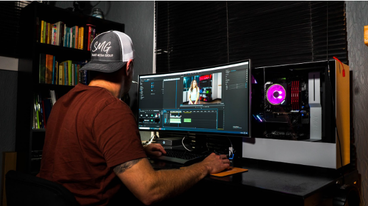The evolution of Artificial Intelligence (AI) has brought about a significant transformation in various industries, with the realm of video editing being no exception. For beginners, navigating this landscape can be daunting due to the sheer complexity of traditional video editing software.
However, AI video editing tools have emerged as a game-changer, simplifying the editing process and making it more accessible to novices. This comprehensive guide aims to equip beginners with the knowledge and skills needed to harness the power of AI in video editing.
Understanding AI Video Editing Tools
AI video editing tools use artificial intelligence to automate many of the tasks that would normally require manual input from a video editor. These tools can analyze video content, automatically perform cuts, and transitions, and even suggest enhancements that could improve the quality of the final product.
The primary goal of AI in this context is to reduce the time and effort required to produce high-quality video content, making it an ideal solution for beginners looking to create compelling videos.
Benefits of Using AI Video Editing Tools
Efficiency and Time-Saving: AI tools can drastically cut down editing time by automatically performing repetitive tasks such as trimming, cutting, and syncing audio with visuals.
Ease of Use: Many AI video editing platforms are designed with a user-friendly interface, suitable for beginners who may not be familiar with more complex editing software.
Consistency: AI ensures that every edit follows predetermined criteria, maintaining a consistent style and quality throughout the video.
Personalization: Advanced AI tools can analyze audience engagement and feedback to tailor content that resonates more effectively with viewers.
Getting Started with AI Video Editing Tools
Before diving into the mechanics of using an AI video editing tool, it is important to choose the right platform that suits your needs. Tools like InvideoAI, Adobe Premiere Pro’s Sensei, Magisto, or Lumen5 offer various features geared towards different types of video content, from social media clips to professional-quality films.
Step 1: Selecting Your Tool
Research and select an AI video editing tool that matches your specific requirements, such as the type of content you intend to produce, your technical comfort level, and your budget. Many tools offer free trials, which are perfect for testing out their capabilities.
Step 2: Importing Your Footage
Once you’ve chosen your tool, the next step is to import the footage that you want to edit. This is usually a straightforward process:
- Open the AI video editor.
- Look for an option to import or upload files.
- Select the video files from your device.
Step 3: Basic Edits and AI Enhancements
After uploading your footage, you can begin making basic edits:
- Trimming: Cut out parts of the video that are not necessary.
- Sequence Arrangement: Arrange your clips in a timeline to tell your story.
- Transitions: Add transitions between clips if the editor does not automatically suggest them.
AI enhancements can include:
- Color Correction: AI can automatically enhance colors based on the lighting and genre of the video.
- Audio Adjustment: Background noise reduction and audio leveling are common AI-assisted tasks.
- Text and Titles: AI can suggest optimal text overlays and title placements based on the content of your video.
Step 4: Using AI for Advanced Editing
Leverage AI features for more advanced edits:
- Content Analysis: Some AI editors can analyze the content of your video and suggest thematic edits.
- Face Recognition: Tools with this feature can identify faces and even offer focused editing around people, which is great for interviews or vlogs.
- Object Tracking: AI can track objects throughout a clip, allowing for dynamic text overlays and effects.
Step 5: Finalizing and Exporting
Review the edited video to ensure everything looks as expected. Use this opportunity to learn how your AI tool handles different editing tasks, and make adjustments if necessary. Once satisfied, export the video in the desired format, optimized for your distribution channel (e.g., YouTube, Instagram).
Tips for Maximizing the Use of AI Video Editing Tools
- Experiment: Spend time experimenting with different features to fully understand the capabilities of your AI tool.
- Feedback Loop: Use audience feedback to improve and personalize your video content further.
- Stay Updated: AI video editing tools are constantly evolving, so keeping up with the latest updates and features is crucial.
Conclusion
AI video editing tools represent a significant advancement in making video production more accessible and efficient. For beginners, these tools can demystify the complexities of video editing and unleash creative potential with minimal technical skills. As AI technology continues to evolve, the scope and capabilities of these tools will only increase, offering more sophisticated and intuitive editing options. This guide should serve as a solid foundation for anyone looking to embark on their journey into the world of video editing with AI at their side.




